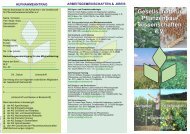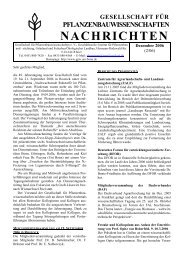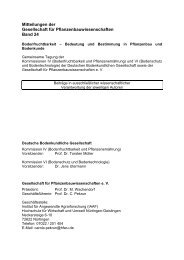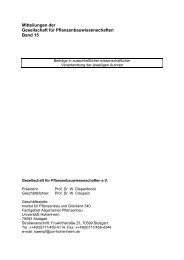Mitteilungen der Gesellschaft für Pflanzenbauwissenschaften Band 23
Mitteilungen der Gesellschaft für Pflanzenbauwissenschaften Band 23
Mitteilungen der Gesellschaft für Pflanzenbauwissenschaften Band 23
Sie wollen auch ein ePaper? Erhöhen Sie die Reichweite Ihrer Titel.
YUMPU macht aus Druck-PDFs automatisch weboptimierte ePaper, die Google liebt.
Mitt. Ges. Pflanzenbauwiss. <strong>23</strong>: 151 (2011)<br />
Manganese leaf tissue tolerance and sensitivity in rice<br />
(Oryza sativa L.)<br />
Martin Duschyk, Hendrik Führs and Walter J. Horst<br />
Institute of Plant Nutrition, Gottfried Wilhelm Leibniz University-Hannover. E-Mail: duschyk@pflern.unihannover.de<br />
Introduction<br />
On acid soils of many tropical and subtropical regions Mn toxicity reduces yields of<br />
crops (Foy, 1984). In subsistence agriculture liming is often not economic or<br />
recommended. Great differences in Mn sensitivity were observed between different<br />
species and cultivars, which could contribute to develop Mn-tolerant cultivars. Rice<br />
(Oryza sativa) represents a plant species with generally high Mn leaf-tissue tolerance<br />
compared to other cereals. The physiological and molecular mechanisms of Mn<br />
tolerance in rice are not yet un<strong>der</strong>stood.<br />
Material and Methods<br />
In addition to necrosis and chlorosis primarily typical Mn toxicity symptoms in rice are<br />
brown spots on old leaves which consist of oxidized Mn and oxidized phenols (Horst,<br />
1988).Therefore, the area of brown spots was used as parameter for the screening<br />
for Mn sensitivityof a Recombinant Inbred Line (RIL) population of 92 individuals.<br />
Since preliminary studies substantiated that also in rice the apoplast is a key<br />
compartment for Mn tolerance (Führs et al. 2010), apoplastic washing fluid (AWF)<br />
was extracted from leaves and activities NADH-peroxidase, guaiacol-peroxidase, the<br />
protein, phenol and Mn concentrations were measured.<br />
Results and Discussion<br />
The phenotyping for Mn toxicity symptoms of the RILs revealed great differences in<br />
Mn tolerance among the population exceeding by far the differences between the<br />
parents of the population. No correlation existed between Mn toxicity symptoms and<br />
Mn bulk-leaf concentrations. Two tolerant and two sensitive RILs were selected from<br />
this population for further in-depth studies. After prolonged and high Mn supply the<br />
Mn-tolerant RILs showed lower activities of NADH- and guaiacol-POD and lower Mn<br />
concentrations in the AWF although the bulk-leaf Mn concentrations did not differ.<br />
References<br />
Foy, C.D. 1984: Physiological effects of hydrogen, aluminium, and manganese toxicities in acid soils.<br />
In: Adams, F. (ed.) Soils acidity and liming. Agron. Monograph 12 ASA-CSSSA, Madison, USA, pp.<br />
57-97<br />
Führs, H. et al. 2010: Physiological and proteomic characterization of manganese sensitivity and<br />
tolerance in rice (Oryza sativa) in comparison with barley (Hordeum vulgare). Annals of Botany<br />
105:1129-1140.<br />
Horst, W.J. 1988: The physiology of Mn toxicity. In: Graham, R.D., Hannam, R.J., Uren, N.C. (eds.)<br />
Manganese in soils and plants. Kluwer, Dodrecht/Boston/London. pp 175-188.







